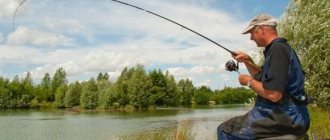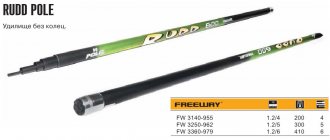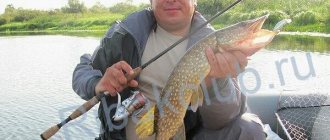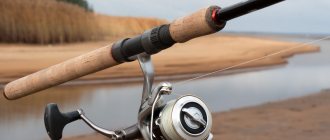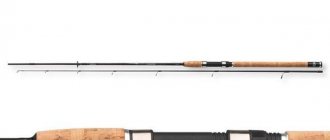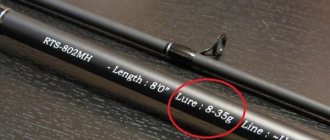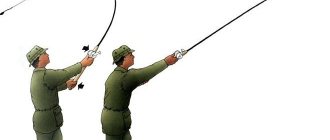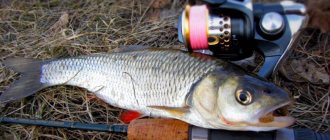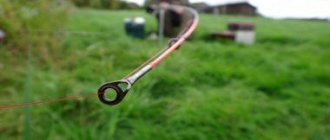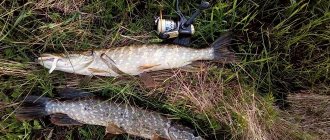How to choose a spinning rod - Almost every angler has asked this question at least once in his life. If you decide to buy a spinning rod, I advise you to find an experienced fisherman among your friends, let him help you make a choice. Before going to the store to buy a spinning rod, you need to roughly determine the following points: the amount you are counting on, the expected size of future trophies, type of fishing, fishing conditions, type and weight of artificial bait, required casting distance.
How to choose the right spinning rod
You can, of course, try to choose a “universal” spinning rod, say, 2.4 meters long with a bait test of 5-25 grams. Many people, including myself, started with universal tackle, but in the end came to the conclusion that a fisherman’s arsenal should include several specialized rods that are best suited for certain fishing conditions.
First, let's figure out what a “universal” spinning rod with the above characteristics is. Its length – 2.4 meters – will allow you to fish comfortably both from the shore and from a boat. But this comfort will be relative, because for a boat there is nothing better than a spinning rod with a height of 1.8-2.1 meters, and for the shore - 2.7-3 meters.
The 5-25 gram test will allow you to throw all types of baits: spinners, spinners, wobblers, jig baits. However, light baits (for example, spinners numbers “00”, “0” and “1” according to the Mepps classification) will not fly far enough, especially if the casting technique is not “set”, and you are unlikely to feel them when retrieving. And with heavy baits (for example, jig heads weighing 20 grams or more), you risk overloading the spinning rod, which will ultimately lead to its breakdown.
The conclusion can be drawn as follows: lovers of the “universal” will still have to make a compromise, and even a spinning rod “for all occasions” has its own “area of action”.
Thus, before buying a spinning rod (or even asking advice from experienced colleagues on the forum), decide in what conditions you plan to fish most often. Answer the following questions:
- What kind of body of water will it be: a deep river with a current or a stagnant bay, a shallow lake or a reservoir?
- Will fishing be done from a boat or from the shore?
- What kind of fish and what size do you plan to catch?
- Perhaps you have already decided on the type of bait? In this case, the spinning rod should be chosen for them. For example, one model is suitable for jig fishing, a completely different one for oscillating spoons, and a third for jerkbaits.
Now is the time to decide what parameters you should pay attention to when choosing gear. There are three of them: the length of the rod, its action and the lure test.
Everything should be clear with the length; in most cases it ranges from 1.8 to 3 meters.
Rating of spinning rods for twitching
- Croix Legend Elite LES70MF2 It is considered one of the best, both according to twitching experts and from the position of the manufacturer. Its cost is 20000+. Messenger, durable, highly sensitive.
- Norstream Rebel RBS-732MMH Spinning rod is specially adapted for jerk twitching. Short form, spaced EVA handle. Convenient for shore fishing and twitching from a boat (6 different modifications). The carbon base adds strength to the tool, with sufficient flexibility. The tuning is regular, quite rigid, highly sensitive. Two-knee, schematically - butt in a whip. Anti-wrap rings. The silicon carbide insert provides improved sending qualities. The cost is in the mid-budget segment.
- Black Hole Pro Team 742ML Spinning rod from a Korean manufacturer. Assembled length 115 cm, working length 221 cm. Material – carbon. Reinforced with a special mesh, which adds strength. Spread EVA handle. The action is fast, light class, up to 18g, you can actually increase it by a couple of grams. It can be attributed to the middle segment, but there is an opinion that the price is somewhat overpriced.
- Major Craft RESTIVE RTS-802L The blank consists of two elbows with a total length of 244cm. Somewhat large for a boat, but convenient for the shore. Build fast, test from 5 to 15 g. If there is a current and aggressive wiring, it may fail. An easy message to long distances, by twitching standards.
- FAVORITE Exclusive Twitch Special EXST-662M Two elbows connected by marks. Length 213 cm, can be an effective tool in the coastal area and from a boat. Test 7-35 g, equipped with a hookkeeper, according to reviews, baits from 10 g are felt better. The long handle (37.5 cm) may cause inconvenience. Not tough enough for minochs. Marked as comfortable, highly sensitive, despite some shortcomings.
- Norstream Provokator PRS-622L The manufacturer positions it as tackle for chub. On the border of ultralight (3-14 g), weight - 97 g, length 189 cm, comfortable handle, only 20 cm. The hollow tip during a quick test gives an understanding of the bottom relief. Cork butt and foregrip. Can be described as a soft stake. It is considered universal, convenient for twitching from a boat.
The Norstream Rooky RKS-662M can be attributed to the budget category. Showed itself excellently in guiding medium mines. It is declared as universal, but it works well in jerks and gives good animation for different types of jerks.
Selecting the material from which the spinning rod is made
Fiberglass. The advantages of fishing rods made from fiberglass are their relative cheapness and unpretentiousness, that is, they do not require special care. But their main disadvantage is their large mass. If you actively fish using a fiberglass rod, your hand will get tired very quickly. Spinning rods made of fiberglass can only be used for trolling, where frequent casting of bait is not required.
Composite Composite spinning rods have average rigidity. The composite is created when fiberglass fibers are added to carbon fibers. I advise you to purchase spinning rods made of composite only if you cannot afford to purchase a carbon fiber rod. At the moment, a huge number of relatively inexpensive carbon fiber rods have appeared in markets and stores, from which you can choose a good spin.
Carbon fiber, carbon fiber, graphite, carbon are the same thing. The lightest in weight are spinning rods made of carbon fiber. I advise you to choose from this material.
Carbon fiber backs vary in modulus of graphite content M1, M2, M3, etc.
The smaller the module, the greater the flexibility and the longer the vibrations of the spinning tip die out, and this, in turn, negatively affects the casting distance and reduces the reaction speed of the rod. But you shouldn’t get carried away with large modules. More carbon fiber means more rigidity, but also more fragility.
I have quite often come across statements on the Internet that rods with “coal” content modules greater than six in cold weather, especially at sub-zero temperatures, become more fragile and can break. Personally, my friends and I have not encountered this, but such an opinion exists, of course it’s up to you to decide. I advise you to choose from rods with, in my opinion, optimal carbon fiber content modules of five and six (M-5, M-6).
Which spinning rod test should you choose?
The test is a spinning indicator that determines the lower and upper weight limits of the artificial baits used. When choosing a spinning rod, you need to decide what weight the artificial bait you will use when fishing will be. The lower test is the minimum value of the mass of the bait. In simple terms, if the weight of the bait is equal to the value of the lower test, then when retrieving such a bait you will feel its play with the rod, and if the weight of the bait is less than the value of the lower test, then when retrieving, you will not feel the play of the bait with the spinning rod.
The lure test (or just test for short) is the most important characteristic of a fishing rod. Shows the weight range within which the baits used must fit. The upper limit of the test is the permissible weight limit, systematically exceeding which, sooner or later you will break the rod. The lower limit is the minimum weight of the spinner (or jig head, or wobbler), which is able to load the spinning rod so that it “works” and, roughly speaking, serves as a “catapult” when casting. However, remember that the manufacturer does not always honestly, to the nearest gram, indicate the test of the rod, especially the lower one.
For example, a test of 1-5 grams means that the spinning rod is “sharpened” for the lightest baits. However, this does not make it impossible to catch large fish with it. It will just take longer to fish it out, and a well-tuned friction brake of the reel will help to avoid breakage during strong jerks.
The upper value of the test is the maximum weight of the bait that can be cast with this rod without the risk of breaking it. In terms of the weight of spinning rods used for casting baits, there are ultra-light ones, with a dough of 1-5 g, light 5-15 g, medium 7-25 g, heavy 20 or more grams, but this is all approximately. There are such rods on which, instead of a test, a range of recommended fishing lines for breaking load is printed. For catching small and medium-sized fish, as well as for the thrill of fishing, I recommend a spin with a dough of 0-10 g. My personal opinion is that this is a bit of overindulgence. In addition, such a fishing rod requires delicate care. For catching medium-sized fish on small rivers and lakes, a rod with a test weight of 5-25 g is suitable. The thrill of fishing with such a spinning rod is very excellent. And for medium and large bodies of water, if you need to cast long-distance baits of decent weight, a spin with a dough of 20 g or more is suitable. For trolling you need sticks with large dough, starting from 60 grams.
How to choose a spinning rod system
Spinning rods differ in such indicators as action. The tuning can be fast, medium and slow. A fast action is when, when the rod tip is loaded, the upper third or quarter of the spin tip bends (works). For medium action rods, the upper half works when under load. Otherwise, such a spin is called a semi-parabolic spin. For slow ones, the deflection is three quarters of the total length of the whip; in another way it is also called parabolic.
The action of a rod is how it bends under load. A slow-action spinning rod (“parabolic”) bends from the butt (handle) itself when casting and during retrieving. It is absolutely not suitable for fishing with jigs, wobblers and jerkbaits. However, if you are going to specialize exclusively in “turntables” and “oscillators,” then this is perhaps the best option. All other things being equal, casting with a “slow” spinning rod goes farther, and when fishing from the shore this factor plays one of the first roles.
In spinning rods with fast or ultra-fast action (“fast” or “extra fast”), the upper third bends under load. Rigid and sensitive, such a rod is used when fishing with jigs (classic “stepped” wiring) or minnow wobblers (jerk wiring – “twitching”). At the same time, in order to achieve the greatest casting distance, the bait should be sent sharply, bitingly (you may have to work out the appropriate casting technique).
A medium action spinning rod (“semi-parabolic”) is something intermediate between the types given above, with a claim to versatility.
Spinning rod for small wobblers
Date: May 18, 2021 | 194
Small, ultralight wobblers are quite popular baits today. Both experienced spinning anglers and beginners love to use mini-wobblers to catch perch, trout, chub, ide, even rudd and other quite peaceful fish. Of course, you regularly come across both zander and pike. Beginners, before mastering any new gear, have many problems and questions. One of these questions when choosing ultralight gear is: which spinning rod to choose for fishing with small wobblers. Well, I’ll try to cover this topic based on my experience and vision.
Before describing the characteristics of a spinning rod suitable for our tasks, it is worth deciding what we mean by the term – small wobbler. Whatever we call it, a small, mini, ultra-light wobbler is a voluminous bait weighing up to 5 g, in extreme cases, up to 7-8 g. The length of such a wobbler rarely exceeds 6-7 cm. It is clear that with such a weight, oblong minnow wobblers can be quite long, and cranks, on the contrary, can be very small and more compact. But, all these are ultralight wobblers, based on their weight.
So, we will start from the weight of small wobblers when choosing a rod for fishing with them. This parameter for rods is called test, test weight range of baits. So, the weight of the wobblers used must clearly fit into the real test range of the spinning rod. For example, if you plan to use wobblers weighing up to 5g, then the upper test should be at least 5g. But, two important caveats should be made here.
Firstly, there are different types of wobblers, and their wiring techniques vary. For example, if a wobbler does not create a lot of drag or strong vibration when retrieving, and is simply pulled evenly, then, indeed, a spinning rod with the highest real test gram per gram can go well with it. The wobbler weighs 7g, and the test rod weighs 1-7g. But such pot-bellied wobblers as cranks or fats create slightly more resistance. As a result, they will be fine to throw with the same “stick”, but when retrieving there will be an overload. The same applies to wobblers, which are carried out by twitching and jerking. This also increases the load on the rod blank. So, it’s worth taking more universal rods, with a reserve. That is, if we use wobblers weighing up to 7-8g, then the upper real test will be 10-12g, i.e. 3-5g higher. Or, if we use wobblers up to 3g, then the upper test of 5-7g will do.
Secondly, it is necessary to distinguish between the real test of the rod and the declared test indicated on the form. If the rod is from a European manufacturer, the test is almost certainly too high. And with the indicated 2-10g, we will actually have a real upper test in the region of 7-8g. If the rod is American or Japanese, then the test is indicated close to the real one, or even slightly underestimated.
If there is no other information on the actual test of the rod, just try hooking (or tying) a wobbler to the tip so that it does not overload the tip even with slight wiggles. So, without digital references to markings, we can choose the appropriate spinning rod.
What should be the length of an ultralight spinning rod for fishing with wobblers? There are no dogmas here. Rather, it is more tied to the place of fishing, to the conditions. If we fish from a boat, then there is no point in using a spinning rod that is too long. Usually it is 1.9-2.2m. If we are fishing from a clean bank and need to cast further away, we can choose a spinning rod up to 2.4 m long. In the UL range, longer rods are rarely used. If you are fishing in cramped conditions, from a shore overgrown with bushes, then a stick 1.8 m long will do.
The structure of an ultralight spinning rod for fishing with wobblers can be different, depending on the class of wobblers. If you fish with wobblers that have their own game, and use mainly a uniform retrieve, or a uniform retrieve with pauses, then a fairly slow spinning rod, even a semi-parabolic rod, bending under load, almost beyond the middle, is perfect. A good example is when they catch chub or trout in small fast rivers. They use stubborn crankbait wobblers with a bright game of their own. Then, a spinning rod with a medium or rather slow action perfectly works out the vibration of the bait and everything that happens with the wobbler (transitions to areas with a different flow speed, bites, touching obstacles). In addition, such a very soft spinning rod better absorbs, so to speak, “knits” the fish.
The situation is different if you are going to catch minnows and shads with small wobblers, and use jerks and twitching as the main retrieve. Here, for better transmission of impulses to the wobbler, to instantly dampen residual vibrations of the rod, you should use rods with a fast action. It is the spinning rods with a hollow, so-called, that are optimal. a tubular tip, rather than a soft, glued tip, which is more suitable for microjigging.
Is there a universal spinning rod option? To say no would be cruel and not entirely true. Simply, they are looking for a compromise. Either we twitch well, but we don’t feel the play of stubborn cranks so clearly, or we twitch with a softer rod with some of its failures. Which is also not very good, but tolerable. In the end, all rods are different, and the sets of wobblers are also different. You need to select it depending on what you will focus on.
I deliberately did not name any spinning rod model in this review. Firstly, there are a lot of them. Secondly, no one brought in any money. But I don’t want to mention anyone, to single them out against the backdrop of the many worthy models present on the market today. When choosing a fishing rod, be guided by the parameters described here, and how it will fit in your hand.
Share with your friends:
Category: Tackle Equipment
Tags: Wobblers, Tackle, Twitching, Rod
General recommendations
In the store, pay attention to the following: the rod whip should be straight and without cracks. All rings and the spool holder axle must be on the same straight line. The rings fit tightly, the resin is without cracks, the inserts in the rings should be smooth and not rotate. The nut for attaching the reel to the rod should rotate easily. It is advisable to try to install the coil intended for use and see that when the nut is well tightened, the coil is well secured and does not dangle. Not all markings on a spinning rod should be trusted, especially if you do not purchase the rod from a company store.
In conclusion, I will give a few typical situations that will help novice fishermen navigate the choice of gear.
- Fishing from the shore on a large river (width more than 100 meters) for medium and large fish (pike, perch, pike perch) - spinning rod 2.7-3 meters long, fast or extra fast action, test 7-28, 10-30, 15- 45 grams, baits – jig heads, spoons, wobblers 12-28 grams.
- Fishing from the shore on a small river (10-30 meters) for small and medium-sized fish (pike, perch, chub, ide, grayling) - spinning rod 2.1-2.4 meters long, fast or extra fast action, test from 1-5 up to 4-16 grams, baits – light spinners, wobblers, jig heads.
- Fishing from a boat on a lake or pond without a current - spinning rod 1.8-2.28 meters long, medium, fast or ultra-fast action depending on the type of bait, test 3-12, 4-16, 5-20 grams
- Fishing from a boat on a large river and at great depths for large pike and pike perch - spinning rod 2.1-2.4 meters long, fast or extra fast action, weight from 10-30 to 20-50 grams, bait - large wobblers (10-15 cm), jig heads (18-36 grams)
- Fishing on the lake from the shore or from a boat with minnow wobblers (twitching) - spinning rod 1.8-2.1 meters long, extra fast action, test from 1-7 to 3-14 grams (wobblers up to 3-7 cm), from 3-14 to 5-21 grams (wobblers up to 10 cm), from 5-25 to 7-28 grams (large wobblers - 10-13 cm).
The recommendations given are approximate and may deviate in one direction or another (depending on the conscious preferences of the fisherman, as well as specific circumstances: the depth of the reservoir, the strength of the current, the clutter of the bottom, the distance from the shore of holes, edges and dumps, the likelihood of catching a large trophy, etc.). etc., etc.)
Source
Budget rods for twitching
Among the many cheap spinning rods, it is worth highlighting several models that can be used for high-quality jerking.
- The Sabaneev Master Spin 210 rod allows you to “twitch” baits from 5 to 12 g. This double-legged carbon fiber rod can catch medium-sized pike and perch.
- Salmo has an inexpensive spinning rod for twitching. This is a Salmo Elite X-Twitch MH rod with a length of 1.98 m and a test weight of 5-25 g. It has a good range and allows you to perform any kind of wiring from smooth jerks to aggressive twitching.
- The Norstream Standard 762MH spinning rod has a length of 2.29 m and a test of 7-28 g. The rod works equally well with both small wobblers and monsters weighing more than 20 g and 15 cm long.
